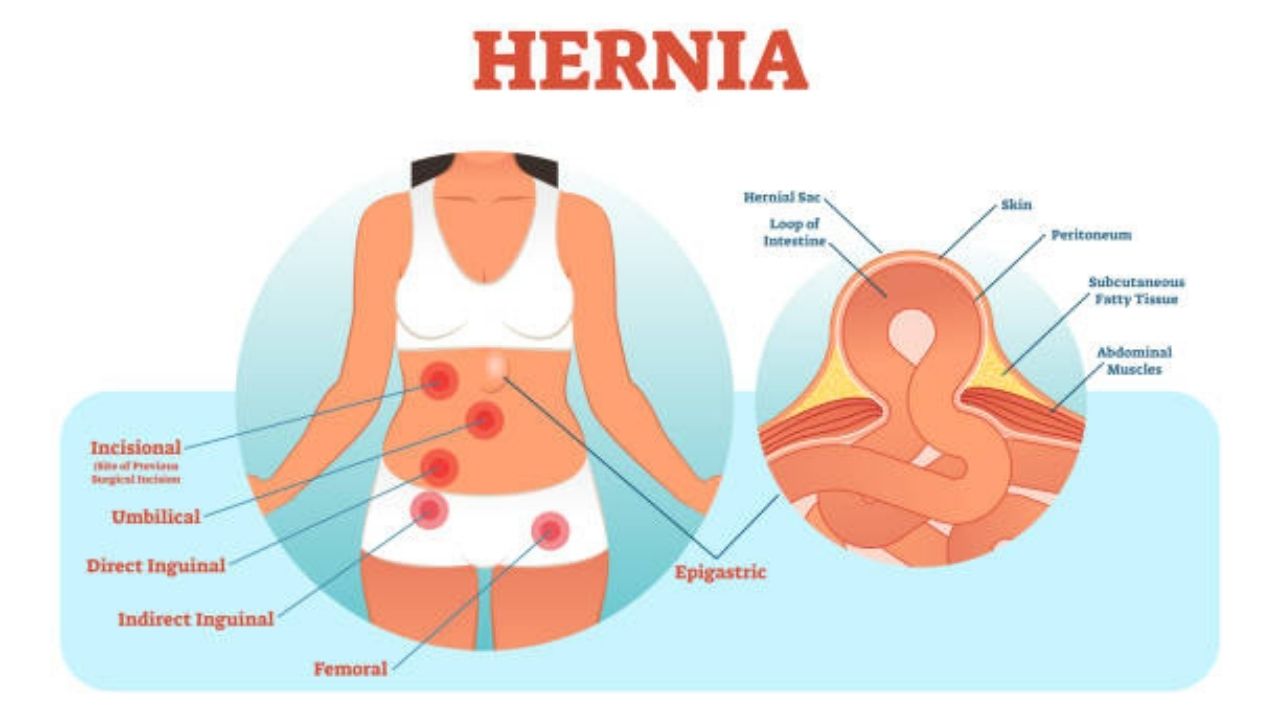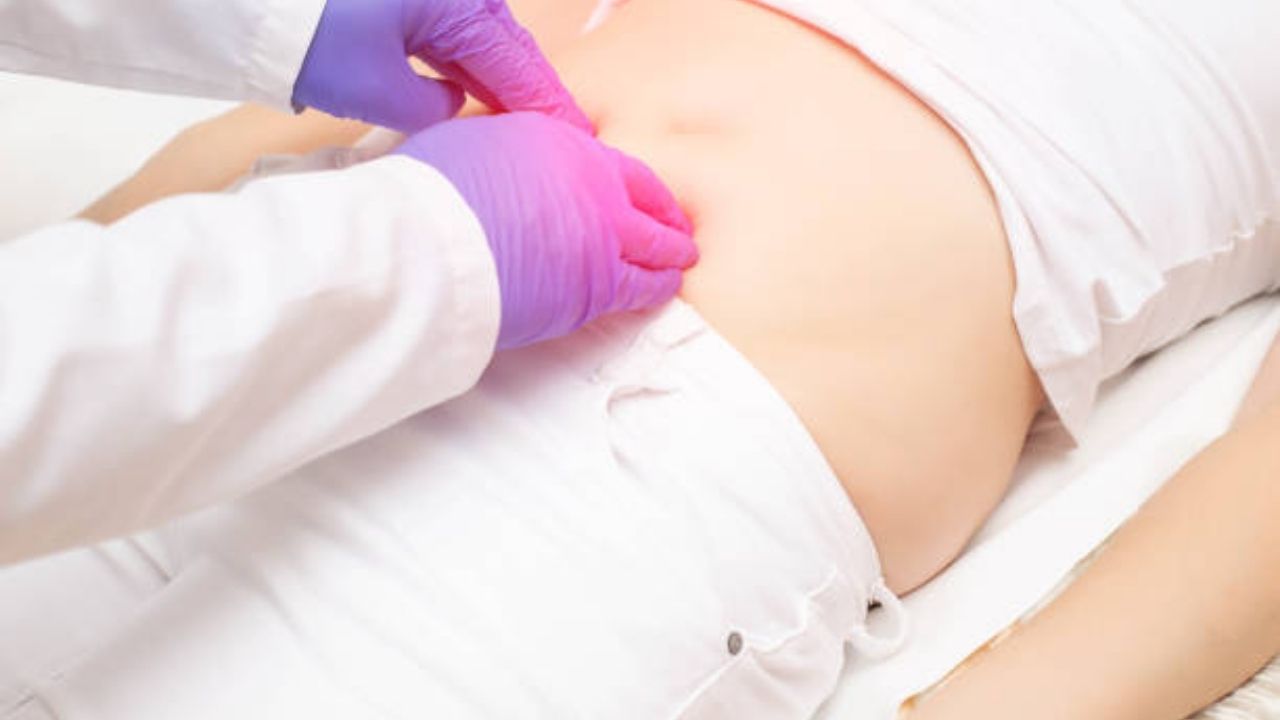An epigastric hernia is also called an abdominal wall hernia or upper abdominal hernia. The contents of the abdominal cavity escape through a weak point in the abdominal wall and form a bulge. If intestines get into the hernial sac and become lodged there, it’s a life-threatening emergency. Read more about symptoms, diagnostics and therapy of epigastric hernia here.
ICD codes for epigastric hernia: K43 | K45
Quick overview
• Symptoms: Often without symptoms, possibly pain, pulling or pressure when tensing the abdominal muscles. Sudden severe pain, nausea and vomiting indicate potentially life-threatening organs being trapped in the hernial sac.
• Causes and risk factors: congenital or acquired connective tissue weakness, minor fractures may enlarge when lifting heavy loads, straining or severe coughing; Risk factors: obesity, pregnancy, high pressure in the abdomen due to tumors or fluid retention; occurs in families.
• Diagnostics: palpation of the abdomen with and without coughing or tensing, rarely additional ultrasound examination.
• Treatment: No treatment for small fractures without symptoms, surgery for larger fractures or in an emergency if organs are trapped.
• Prognosis: Usually harmless disease without treatment for small fractures, for larger fractures after surgery it is easy to heal with enough rest to recover.
• Prevention: Avoid risk factors such as being overweight, pay attention to good lifting technique when lifting heavy loads.
What is an epigastric hernia?
Doctors speak of a hernia in the abdominal wall (synonymous with “abdominal hernia”) when the abdominal wall bulges outwards at a weak point in the abdominal wall and forms a so-called hernia sac. Epigastric hernias are relatively rare compared to other hernias with a proportion of five percent. Men are affected three times more often than women.
A hernia is either congenital or acquired later. Epigastric hernia occurs in both children and adults, typically between the breastbone and the belly button—sometimes in more than one place.
A distinction is made between the epigastric hernia and the inguinal hernia and the so-called rectus diastasis. In the case of inguinal hernias, which occur in male infants and small children, a connection between the scrotum and abdomen remains in the first year of life due to the late migration of the testicles into the scrotum. In some cases, organs slide into this connection and one speaks of an inguinal hernia.
In diastasis recti, the left and right strands of the straight abdominal muscles (six-pack, rectus abdominis muscle) diverge. This leads to an even elevation of the midline (linea alba) between the navel and the breastbone. This is not a hernia as there is no hernia sac. There is a risk of entrails being trapped. Surgery is primarily for aesthetic reasons.
Other hernias are femoral hernia, incisional hernia (scar hernia), umbilical hernia or diaphragmatic hernia.
Epigastric hernia: what are the symptoms?
A hernia in the abdominal wall often causes no discomfort or pain. Nevertheless, it is advisable to consult a doctor for further clarification. Typical symptoms of a hernia in the abdominal wall are usually chronic pressure problems in the upper abdomen or burning, pain or pulling. The symptoms often worsen when you sit up, sneeze or have a bowel movement.
A larger abdominal wall hernia is often clearly visible and often psychologically stressful for those affected.
Symptoms such as sudden pain in the area of the hernia indicate that abdominal organs are trapped in the hernial sac. It is possible that the blood supply to the organ is interrupted – which can be life-threatening. In this case, urgently go to the doctor. Nausea and vomiting are other typical symptoms.
If you suddenly experience severe abdominal pain with nausea and vomiting, do not waste any time and, if in doubt, call the emergency services. In addition to a hernia in the abdominal wall, these symptoms may hide other serious or life-threatening diseases.
Epigastric hernia: causes and risk factors
Although some children are born with a diagnosis of epigastric hernia, it is actually more likely to occur in older people. Because the increasing weakness of the connective tissue in old age favors hernias. The connective tissue is also often weakened in overweight people, which means that tears and hernias are more common.
High intra-abdominal pressure from chronic constipation or heavy lifting also promotes abdominal wall hernias and other hernias. An important risk factor is family history. If your parents, siblings or grandparents are known to have hernias in your own family, there is an increased risk of suffering an abdominal wall hernia or another hernia in the course of your life.
Tumors or accumulations of fluid in the abdomen in some diseases (a “fat” or “distended abdomen”) also promote abdominal wall hernias and other hernias. Pregnant women are also more often affected. Heavy lifting, coughing, or straining are factors that often enlarge an existing small hernia.
Who gets epigastric hernia?
About 75% of epigastric hernia happen in males.
Epigastric hernia: investigations and diagnosis

If you suspect you are suffering from an epigastric hernia, it is best to see your family doctor or a gastroenterologist. He will first try to talk to you (anamnesis). A physical examination follows. The doctor asks the patient to cough or tense their stomach to feel for changes. Due to the increased abdominal pressure, a bulge can usually be felt. This hernia sac, which bulges under pressure, confirms the doctor’s diagnosis of abdominal wall hernia.
An ultrasound examination is only necessary in a few cases.
How is an epigastric hernia treated?
Overall, with an epigastric hernia, there is little risk of pinching abdominal organs. Smaller upper abdominal hernias, which account for the majority of cases, usually remain without symptoms. The doctor usually only recommends therapy if there are symptoms and if a larger fracture causes organs to be pinched, which constitutes a medical emergency.
In this case, the surgeon removes the hernial sac during the operation and transfers the contents of the hernial sac back into the abdomen. The doctor often uses plastic mesh to reinforce the abdominal wall to prevent another hernia sac. The suture is often sufficient to close the fracture in the long term.
A hernia that is herniated is usually an emergency and you should call emergency services.
Epigastric hernia: disease course and prognosis
In most cases, epigastric hernia is a harmless condition. As a rule, the patients have not had any symptoms for many years. If symptoms occur, an operation is often necessary. If, in rare cases, organs are trapped in the hernial sac, this is a medical emergency and an operation is unavoidable.
Behavior after abdominal wall hernia surgery
An abdominal wall hernia operation is usually not a major operation. After the operation, however, the wound must have time to heal in peace so that new hernias do not develop.
Depending on the size of the operated fracture, doctors usually recommend avoiding physical activity for two to three weeks. For up to three months after surgery, doctors advise against heavy lifting.
Depending on the size of the operation and its course, sick leave is usually for a period of between seven and 14 days. How long you are actually absent after an abdominal wall hernia operation naturally depends on the type of activity. Heavy physical work is not possible for up to three months afterwards.
Prevention of epigastric hernia
In principle, it makes sense to avoid risk factors such as being very overweight or lifting heavy weights. Appropriate lifting techniques (“squatting instead of standing”) or abdominal belts for lifting heavy loads also help.
When should I call the doctor?
Call the surgeon if your child had surgery and:
- Has a fever of 101.5°F or higher for more than 24 hours.
- Has redness that spreads around the surgery area.
- Has bleeding, swelling, or drainage from the surgery area.
- Has severe, lasting pain at the surgery area.
- Can’t pee within 8–12 hours after surgery.
- Is vomiting.
- You have any other concerns.
